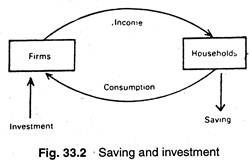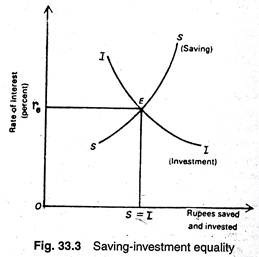The following points highlight the five main classical views on income and employment. The classical views are: 1. Say’s Law 2. Saving, Investment and the Rate of Interest 3. The Money Market 4. Price Flexibility 5. Wage Flexibility.
Classical View # 1. Say’s Law:
Say’s Law is the simple notion that the supply of goods and services creates its own demand, i.e., the very act of producing goods and services generates an amount of income equal to the value of the goods produced. That is, the production of any good would automatically provide the wherewithal to take the output off market.
The essence of the Law that supply creates its own demand can be envisaged most easily in terms of a simple barter economy. A farmer, for example, produces or supplies wheat as a means of buying (or demanding) the shoes, shirts and other things produced by shoemakers and craftsmen.
The farmer’s supply of wheat is equivalent to his demand for other goods. This is true for other producers and for the whole economy; demand must be the same as supply.
ADVERTISEMENTS:
In fact, the circular flow model of the economy and national accounting both suggest this sort of relationship. For instance, the income created from the production of any level of total output would, when spent, be just sufficient to generate the same level of demand.
The Says’s Law is equally applicable in a modern economy which uses money as a medium of exchange and store of value. Here any excess supply of money possessed by an individual implies excess demand for goods and vice versa. So for the economy to be in equilibrium the sum of the excess supply functions must be zero.
If the composition of output is in accord with the tastes and preferences of consumers, all markets would be cleared of their outputs. Thus all the businessmen need to do to sell a full employment output is to produce that output. The Say’s Law assumes that there will be sufficient consumption demand so as to clear the market.
Classical View # 2. Saving, Investment and the Rate of Interest:
There is, of course, a serious omission in Say’s Law. If the recipients of income in this simple model save a portion of their income, consumption expenditure will fall short of total output and supply would no longer create its own demand. Consequently there would be unsold goods, falling prices, cutbacks in production, unemployment and falling incomes.
ADVERTISEMENTS:
However, the classical economists ruled out this possibility by suggesting that saving would not really result in a deficiency of total demand, because each and every rupee saved would be automatically invested by business firms. That is, investment would occur to fill any consumption ‘gap’ caused by savings leakage.
In fact, businessmen produce not only consumption goods for sale to households but investment (capital) goods for sale to other firms (or to one another). The latter constitute a considerable portion of society’s total output. In other words, investment spending by business will add to the income- expenditure stream.
This may fill any consumption gap arising from saving. Thus, if private business firms as a group intend to invest as much as households want to save, Say’s Law will hold and the levels of national income and employment will remain constant.
To illustrate Say’s Law consider Fig. 33.2. It shows a simplified version of the circular flow of income diagram. There are only two sectors—households and private business firms. Households receive income exactly equal to the value of goods and serviced produced.
ADVERTISEMENTS:
A part of this income is spent on consumption goods, the balance is saved. Thus consumption demand falls short of the total value of production (GNP) by the amount of saving, which is made up by demand for capital goods (i.e., investment demand).
Thus, so long as investment and saving are equal, aggregate demand (i.e., consumption demand plus investment demand) will ways be equal to the total value of production.
Thus whether or not the economy would be able to achieve and sustain a level of spending sufficient to provide a full employment level of output and income therefore would depend upon whether the desired investment of business firms was offset by desired saving of the household sector.
Classical View # 3. The Money Market:
The classicists also argued that capitalism contained a special market—the money market—which would ensure saving-investment equality thus would guarantee full employment.
According to them the rate of interest (the price paid for the use of money) was determined by the demand for and the supply of capital. The demand for capital is investment and its supply is saving. So the equilibrium rate of interest (re) is determined by the saving-investment mechanism.
The equilibrium rate of interest is one which brings about S — I equality. Any imbalance between S and I would be brought about by changes in the rate of interest (r). IF S exceeds I, r will fall. This stimulates investment. The process will continue until and unless the equality is restored. The converse is also true. See Fig. 33.3.
Classical View # 4. Price Flexibility:
The classicists also argued that the level of output which producer can sell depends not only upon the level of aggregate demand but also upon the level of product prices.
ADVERTISEMENTS:
Thus even if the interest rate fails to equate the desired S of the household sector with the intended I of private business firms, any resulting decline in total spending would be neutralised by proportionate decline in the price level. That is Rs. 100 will buy two shirts at Rs. 50, but Rs. 50 will buy the same number of shirts provided their price falls to Rs. 25.
Therefore, if households somehow succeeded in saving more than business firms were willing to invest, the resulting fall in total spending would not be a decline in real output, real income, and the level of employment provided product prices also declined in the same proportion as aggregate expenditure.
According to classical economists competition among sellers would ensure the flexibility. A general decline in demand in product market will force competing products to lower their prices to clear their accumulated surpluses.
Thus the result of excess saving would be to lower prices. This will raise the value of money and permit non-savers to acquire more goods and services with a fixed money income. Saving would, therefore, lower prices but not output and employment.
Classical View # 5. Wage Flexibility:
ADVERTISEMENTS:
But this is not perhaps the whole truth. A fall in product price would reduce resource price particularly wage rate in the process.
Thus wage rates have to decline significantly to permit business to produce profitably at the now lower prices. The classical economists thought that a decline in product demand would automatically be translated into a fall in demand for labour and other resources.
The immediate result would be an excess supply in the labour market, i.e., unemployment at the existing wage rate. The wage rate will fall.
The producers, who were reluctant to employ all workers at the original wage rate, will now find it profitable to employ extra workers at lower wage rate. And competition among unemployed workers would force them to accept lower wages rather than remain unemployed.
ADVERTISEMENTS:
The process will come to a halt only when the wage rate falls enough to clear the labour market. So a new lower equilibrium wage rate will be established. Thus involuntary unemployment was logical impossibility in the classical model. Anyone willing to work at the market determined wage rate would be able to find jobs readily.

